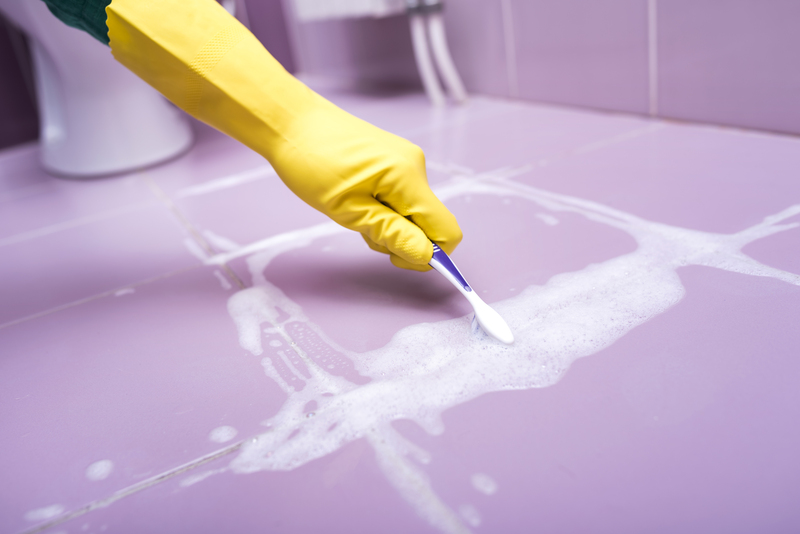Best Habits to Adopt for a Mold-Free Bathroom
Posted on 14/08/2025
Best Habits to Adopt for a Mold-Free Bathroom
Mold is a persistent and unwelcome guest in many homes, especially in damp environments like bathrooms. Not only is it unsightly, but prolonged exposure can also pose health risks. The good news? With a few simple adjustments and best practices for a mold-free bathroom, you can keep your space clean, fresh, and healthy. In this comprehensive guide, we'll share actionable steps and expert strategies to maintain a mold-free bathroom environment.
Why Is Mold a Problem in Bathrooms?
Bathrooms are the perfect breeding ground for mold. The high humidity levels, constant moisture, warmth, and lack of ventilation offer ideal conditions for mold spores to thrive. Besides damaging fixtures and grout, bathroom mold can trigger allergies, asthma, and other respiratory ailments. Understanding the causes is the first step toward prevention.
How Mold Grows in Bathrooms
- Moisture Accumulation: Showers, baths, and sinks generate lots of moisture, which, if not removed, promotes mold growth.
- Poor Ventilation: Inadequate airflow prevents moisture from evaporating, creating damp spots where mold can sprout.
- Lack of Sunlight: Sunlight inhibits mold, but most bathrooms are naturally dark, favoring mold proliferation.
- Organic Materials: Items like shower curtains, wood, and even soap residue can feed mold colonies.

Top Habits for a Mold-Free Bathroom
Ready to combat mold for good? Incorporate these best habits and practices to prevent bathroom mold and maintain a sparkling, healthy home.
1. Improve Bathroom Ventilation
Effective ventilation is the cornerstone of a mold-resistant bathroom. Stagnant air allows moisture to settle and, in turn, becomes a haven for mold.
- Use Bathroom Fans: Always switch on the exhaust fan while showering and leave it running for at least 20 minutes after to expel excess moisture.
- Open Windows: If possible, open windows during and after showers to allow fresh air circulation and hasten evaporation.
- Check for Blockages: Dust and clean exhaust vents regularly to ensure maximum efficiency.
- Consider Dehumidifiers: A small bathroom dehumidifier can significantly lower overall humidity, especially in windowless bathrooms.
2. Control Humidity Levels
High humidity is a leading cause of black mold in bathrooms. The aim is to keep humidity levels below 50%.
- Use a Hygrometer: This handy device monitors your room's humidity, so you'll know when it's time to ventilate.
- Fix Leaks Promptly: A dripping faucet, leaky toilet, or shower can elevate humidity and create constant dampness. Prompt repairs are crucial.
- Wipe Down Surfaces: After using the shower or bath, quickly wipe down tiles and glass doors to remove lingering water.
- Hang Towels Properly: Wet towels contribute moisture. Always spread them out or hang them outside to dry fast.
3. Clean Regularly With Mold-Preventing Products
Consistent cleaning is one of the best ways to prevent mold in bathrooms. It not only keeps your space fresh but also removes potential sources of nourishment for mold spores.
- Use Mold-Resistant Cleaners: Cleaning agents containing vinegar, hydrogen peroxide, or baking soda can kill and deter mold growth.
- Scrub Tile Grout: Mold loves to hide in grout lines. Use a brush and a baking soda paste or specialized grout cleaner weekly.
- Clean Shower Curtains and Liners: Wash or replace often, as they tend to collect soap scum and moisture.
- Sanitize Problem Areas: Target corners, under sinks, and behind toilets where moisture and organic material gather.
Tip: Never mix bleach with ammonia-based products; the combination can be toxic.
4. Seal and Protect Bathroom Surfaces
Shielding vulnerable areas can be a game-changer for long-term bathroom mold prevention.
- Seal Grout Lines: Apply a grout sealer annually to make it less absorbent and easier to clean.
- Use Mold-Resistant Paint: Opt for mildew-resistant paint in bathrooms and touch up areas as needed.
- Replace Old Caulk: Inspect and replace peeling or cracking caulk around the tub and sink. Mold can hide behind worn-out caulk and continue spreading.
5. Reduce Clutter and Promote Airflow
Overcrowded bathtubs and counters prevent air from circulating freely and make cleaning harder.
- Keep Surfaces Clear: Store lotions, shampoos, and other products in cabinets or shower caddies.
- Hang Items Properly: Loofahs, brushes, and sponges should hang freely to dry completely between uses.
- No Carpets or Mats: Avoid wall-to-wall carpeting in bathrooms -- stick to washable mats that dry quickly.
6. Address Water Spills and Condensation Quickly
Even small puddles provide enough moisture for bathroom mildew to grow. Make it a habit to:
- Wipe Up Promptly: Dry any water from the floor, sink, or countertops immediately after use.
- Check for Condensation: If you notice water droplets on windows or walls, dry them and increase ventilation.
7. Inspect and Maintain Your Bathroom Regularly
Routine checks are vital for stopping mold before it starts.
- Look for Early Signs: Pay attention to peeling paint, musty odors, or discoloration on walls and ceilings -- early mold signs.
- Check Behind and Under Fixtures: Mold can hide behind toilets, under sinks, and even inside cabinetry.
- Professional Inspections: For persistent problems, consult a mold remediation expert for a thorough check-up.
Smart Bathroom Design for Mold Resistance
Sometimes, prevention starts before the first sign of trouble. If you're remodeling, renovating, or designing a new bathroom, consider these mold prevention bathroom tips:
Choose Mold-Resistant Materials
- Ceramic and Porcelain Tiles: Non-porous surfaces are harder for mold to penetrate.
- Vinyl and Waterproof Flooring: Ditch absorbent materials like wood that can retain moisture.
- Mold-Resistant Drywall: Greenboard and cement board are made for high-humidity areas like showers.
Install Effective Fixtures and Layouts
- Modern Ventilation Systems: Invest in high-quality exhaust fans with humidity sensors for hands-free operation.
- Sloped Shower Floors: Proper drainage prevents lingering puddles.
- Wall-Mounted Vanities: Keeping cabinetry off the floor improves airflow and reduces mold risk.
Natural Remedies and Eco-Friendly Mold Prevention
If you prefer to avoid harsh chemicals, there are several natural solutions for a mold-free bathroom:
- White Vinegar Spray: Vinegar is a natural antifungal. Spray on affected surfaces and let it sit for an hour before rinsing.
- Baking Soda Paste: Combine water and baking soda for scrubbing grout and tiles.
- Tea Tree Oil Solutions: Mix a teaspoon of tea tree oil with water in a spray bottle for a powerful, non-toxic mold deterrent.
- Lemon Juice: Its natural acidity helps to break down mold and provides a fresh scent.
Note: Always patch-test on a small area before using any natural remedy extensively.
Mistakes to Avoid for a Mold-Free Bathroom
- Skipping Regular Cleaning: Mold can establish itself quickly if cleaning is infrequent or incomplete.
- Ignoring Leaks and Dampness: Even minor drips can feed mold growth over time.
- Using Absorbent Shower Mats: If not dried properly, they become prime spots for mildew.
- Overcrowding Bathroom Spaces: Dense storage limits airflow and cleaning access, encouraging mold.
Quick-Reference Checklist: Mold-Free Bathroom Habits
- Ventilate after every shower or bath
- Wipe down wet surfaces immediately
- Fix leaks as soon as discovered
- Wash and dry towels properly
- Clean grout, corners, and fixtures weekly
- Use mold-resistant materials and paint
- Keep clutter to a minimum
- Inspect for early signs of mold regularly

Frequently Asked Questions About Mold in Bathrooms
Q: What are the first signs of mold in a bathroom?
A: Look for black, green, or brown discoloration, a musty smell, or even peeling paint. Mold often starts in grout lines, corners, and around windows.
Q: How often should I clean my bathroom to prevent mold?
A: A thorough cleaning once per week, with quick wipe-downs after each shower, offers strong protection against mold in bathrooms.
Q: Can I eliminate mold with household products?
A: Small outbreaks can often be managed with vinegar, baking soda, or hydrogen peroxide. For heavy or persistent mold, a professional is recommended.
Q: Are there paints that prevent bathroom mold?
A: Yes! Mildew-resistant or mold-resistant paints contain additives that prevent spores from settling and growing.
Q: Should I replace caulk and grout if I see mold?
A: Yes, especially if scrubbing doesn't remove it entirely. Remove the affected caulk or grout, treat the area with an antifungal solution, and reapply with mold-resistant products.
Conclusion: Make Mold-Free Living a Habit
Creating and maintaining a mold-free bathroom is not a one-time task -- it's about adopting daily and weekly habits that prioritize dryness, cleanliness, and vigilance. By following the expert tips and best habits for preventing bathroom mold detailed above, you'll enjoy a healthier, cleaner, and more inviting bathroom environment year-round.
If you find persistent or widespread mold despite your best efforts, don't hesitate to call in professionals for remediation. Remember, prevention is always simpler and more cost-effective than repair. Commit to these small changes for big results and enjoy a truly mold-free bathroom today!




